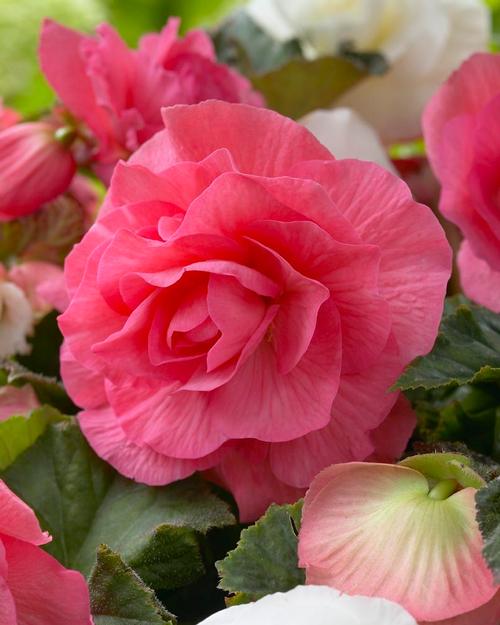Your Guide to Planning, Planting, and Growing Begonias
Begonias brighten up shady areas with their colorful blooms. Unlike most flowering plants, which require at least a half day of full sun, begonias actually prefer growing in the shade. They also never have a down time. Once begonias begin flowering, they bloom continuously from summer to frost.
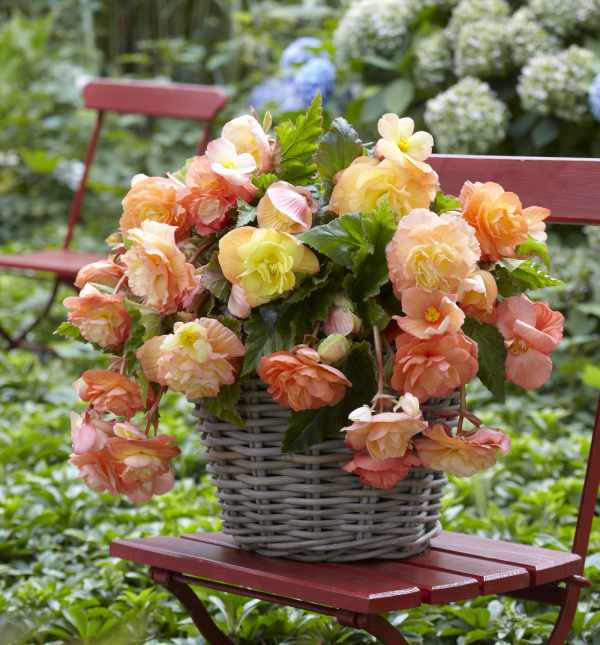
There are several different types of begonias. Wax begonias and angel-wing begonias are usually grown as outdoor annuals or indoor houseplants. Both grow from a clump of roots and are winter hardy in growing zones 9-11. Rhizomatous and rex begonias are valued for their ornamental foliage. They grow from fleshy, creeping roots and are usually maintained as houseplants. Begonia grandis is a hardy perennial begonia (zones 6-9) that’s often grown with hostas and astilbes.
The focus of this article is tuberous begonias. These frost-sensitive plants grow from firm, round to oval tubers. They have either an upright growth habit (for window boxes, flower pots and garden beds) or a cascading habit (for planters and hanging baskets). Most have rose-like flowers and are available in lots of lovely colors. See some of the options HERE.

Start with a Better Tuber
It’s easy to see differences in quality when you compare two tuberous begonia plants side by side. Larger tubers (as shown on the left) produce bigger plants with more stems and more flowers. Longfield Gardens offers 5/6 cm tubers that grow into large, full plants. Begonia tubers that are ready to plant should feel dense and firm like a potato.

Plan for Success
Sun/Shade: Tuberous begonias are sensitive to intense sunlight and should also be protected from extreme heat. They grow best in the filtered light beneath high trees, or in an area that receives about 4 hours of morning or late afternoon sunlight.
Zone: The plants will not survive winter outdoors except in zones 8-11. In cooler climates (zones 3-7), tuberous begonias are usually grown as annuals for flowers from summer through fall. To check your growing zone, use the USDA Hardiness zone map here.
When to Plant: Tuberous begonias will not grow in cold soil. Plant them outdoors in late spring after the soil is warm and all danger of frost has passed. For earlier flowers, the tubers may be started indoors in pots, about 8 weeks before you expect to plant them outdoors. All you need is a pot, some moist growing mix and a warm, sunny location. Start early and your begonias can be in bloom by Memorial Day. Learn more about starting begonias indoors.
Where to Plant: Tuberous begonias require bright light, but not direct sunlight. They grow well in full to partial shade, but may not flower in areas with dense shade and low light. Begonias are ideal container plants for shady gardens, patios, porches and patios. See the range of tuberous begonia flower styles and some container options HERE.
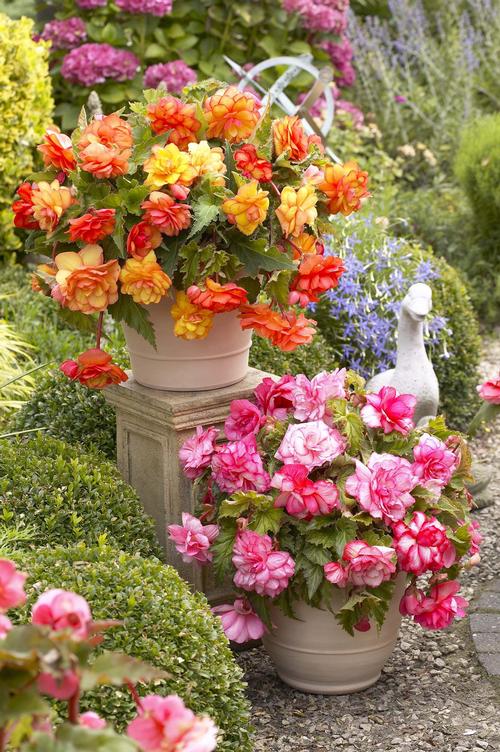
How to Plant Tuberous Begonias
If you are planting begonia tubers directly into the garden, start by loosening the soil and digging a shallow hole. Place the tuber in the hole and cover it with no more than about 1" of soil. If you are starting the tubers indoors, you can plant them in individual pots or in a tray filled with several inches of moist growing mix.
Set the tuber into the hole with the depression facing upward (like a bowl). Learn how to determine which end is up HERE.
If you live in an area with wet spring weather, you can set the tuber at a slight angle, so water doesn't settle in the depression.
Cover the tuber with about 1” of soil and then water lightly to help settle it in place.
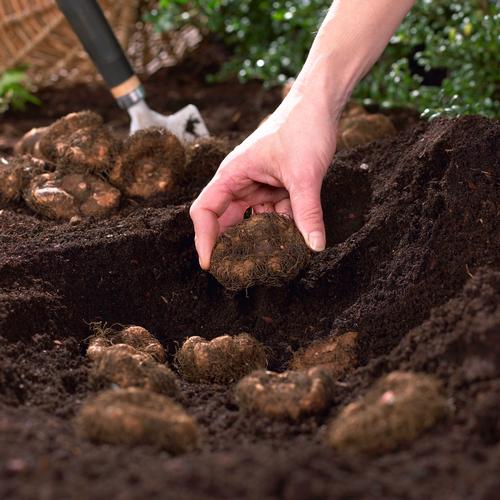
Planting Tips for Tuberous Begonias
After planting, hold off on watering until the first sprouts emerge. Overwatering before you see leaves may cause the tuber to rot. Sprouts should appear in 2-4 weeks.
If you are planting begonias in pots or planters, make sure the containers have a drainage hole on the bottom. Fill them with moistened growing mix that contains about 20% compost. Plant the tuber and cover it with about an inch of soil. When multiple tubers are being planted in the same container, space them 3-4” apart.
If you are growing tuberous begonias in your garden or landscape, plant them in fertile, well-drained soil. Adding compost or topsoil at planting time will improve the fertility of the soil and help it retain moisture.
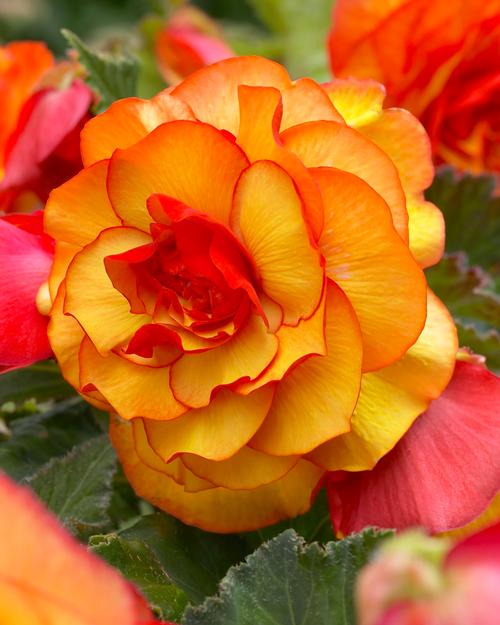
What to Expect
Begonias are tropical plants that need warm soil. If you live in a cool climate, it's best to hold off on planting your begonias outdoors until the soil is 60°F and the nights are settled and warm. In northern areas this will be late May to early June.
Once your begonias have filled out, water them as needed. Make time to drench the entire root ball at least once a week. Allow the soil surface to become dry to the touch between watering as overwatering can lead to rot and disease.
To produce a good show of flowers, tuberous begonias need to be fertilized consistently all season long. Fertilize with fish emulsion early in the season to help the plants bulk up. Once buds appear, switch to an all purpose fertilizer for flowering plants. Follow label directions for dilution rate. Feed every 2 weeks or mix to half strength and feed every week.
It's normal for tuberous begonias to produce a mix of single and double flowers. The single flowers are female and the double flowers are male. After the flowers fade, snip them off to keep the plants looking neat.
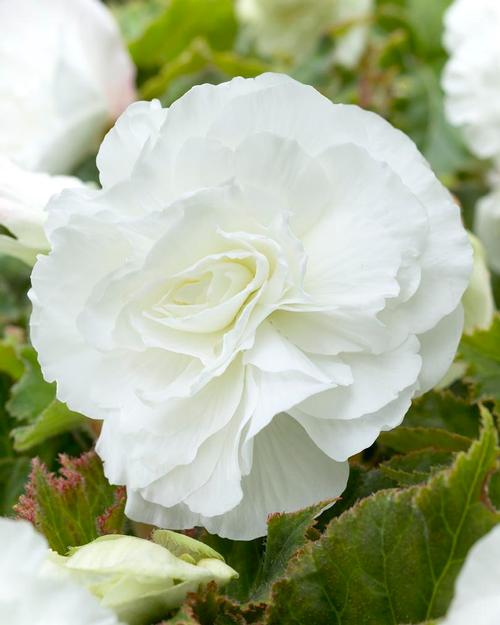
Caring for Tuberous Begonias After They Bloom
Tuberous begonias are sensitive to cold and will not survive freezing temperatures. In zones 3-7, they are usually treated as annuals. At the end of the growing season, simply put the entire plant in your compost pile. If you want to save the begonia tubers and replant them next spring, here’s how to do it:
Begonias that are in containers can be moved indoors before the first frost. Stop watering and allow the foliage to yellow and die back. Store the pots in a cool (50°F), dark place. Alternatively, you can remove the begonia tuber from the pot and follow the directions below.
Tuberous begonias that are growing in the garden should be dug up after the first light frost. Keep the stems attached to the tubers and gently remove most of the soil from the roots. Lay the plants on their sides in a warm, dry place where they will be protected from freezing temperatures.
After a couple weeks, the stems and foliage should easily pull away from the tuber. If not, let the tuber and stems dry a bit longer. Wrap each tuber separately in newspaper or put them in small paper bags. Store these in a cardboard box, in a dry, dark place where the temperature will stay about 50°F.
In warm climates (hardiness zones 8-11) begonia tubers may be left in the ground outdoors, but it's important to keep them from getting too wet during the winter. If you live in a climate with wet winters, you may want to store the tubers indoors, following instructions above.
Shop HERE for tuberous begonias.
